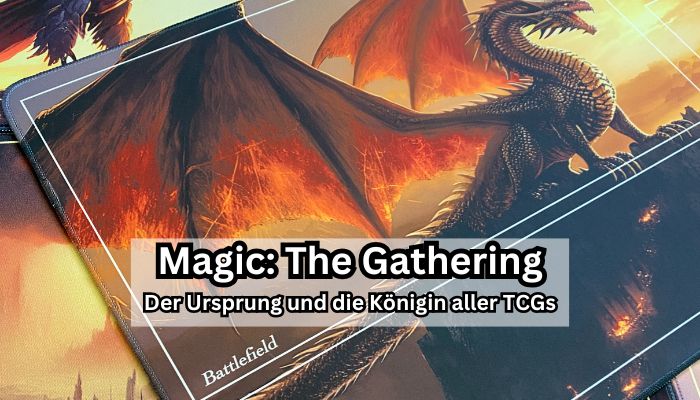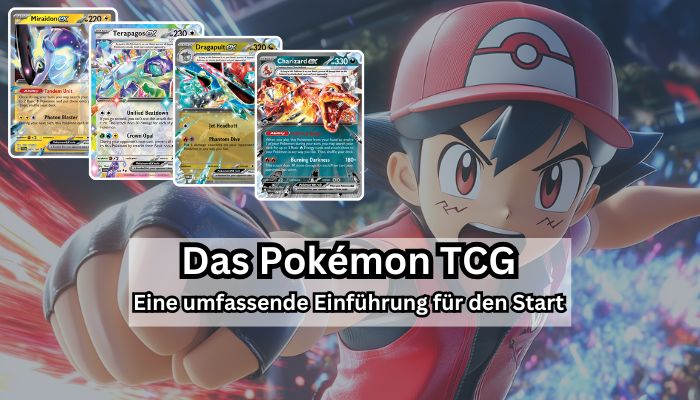introduction
Magic: The Gathering (MTG) is the world's first and most successful collectible card game. Since its launch in 1993, MTG has captivated millions of players worldwide. With its unmatched depth, strategic challenges, and incredible card variety, MTG is more than just a game—it's a cultural experience.
This blog will give you a comprehensive overview of Magic: The Gathering, from the basic mechanics to the special features that make the game unique. Whether you're a beginner looking to take your first steps or an experienced player looking to deepen your knowledge, you've come to the right place.
What is Magic: The Gathering?
Magic: The Gathering was developed in 1993 by mathematician Richard Garfield and published by Wizards of the Coast. It was the first collectible card game ever and laid the foundation for an entire genre. The idea was born out of the vision of creating a portable, strategic game that could be played quickly. The result was a revolutionary card game that combines strategy, luck, and the passion for collecting.
Since its launch, MTG has received numerous expansions and gameplay mechanics that continually evolve the game. It is played worldwide, both in local game stores and at major tournaments. Furthermore, MTG has developed a deep lore told through books, comics, and the cards themselves.
The basics of the game
Magic: The Gathering is a game in which two or more players take on the roles of Planeswalkers—powerful wizards who travel between planes and engage in magical battles. Each player begins with a deck of at least 60 cards and starts the game with 20 life points. The goal is to reduce their opponent's life total to zero or prevent them from drawing cards.
1. The Colors of Magic
One of the most unique features of MTG is the color system, which represents the different play styles and philosophies:
-
White: Represents order, healing, and defense. White cards focus on creature cooperation and life gain.
-
Blue: Symbolizes knowledge and control. Blue cards offer spells that manipulate the board and block opponents.
-
Black: Embodies power and sacrifice. Black cards allow you to sacrifice creatures or exchange life points for benefits.
-
Red: Chaotic and aggressive. Red cards focus on quick damage and destructive effects.
-
Green: Nature and growth. Green cards offer powerful creatures and the ability to generate mana quickly.
Each color has its strengths and weaknesses, and many decks combine multiple colors to develop unique strategies.
2. The construction of a deck
A deck in Magic: The Gathering consists of:
-
Lands: These cards generate mana, the resource you need to cast spells. There are five types of basic lands, corresponding to the five colors.
-
Creatures: Creatures are your primary attack and defense units. Each creature has power and toughness values.
-
Instants and sorceries: These cards offer one-time effects, such as destroying creatures or drawing cards.
-
Enchantments and Artifacts: These cards have permanent effects that can give you advantages.
-
Planeswalkers: These powerful cards represent allies you can bring into play. They have their own abilities that can significantly impact the game.
3. The game process
A game of Magic: The Gathering is divided into rounds, each consisting of several phases. Each round consists of the following seven phases:
-
Untap Phase: At the beginning of your turn, you untap all of your cards that were tapped during the previous turn, such as lands, creatures, or artifacts. This ensures they're ready for use again.
-
Upkeep Phase: During this phase, effects that occur "at the beginning of your turn" are resolved. Some cards have abilities that trigger specifically during this phase.
-
Draw Phase: You draw a card from your deck. The first player skips this phase on their very first turn.
-
Main Phase 1: Here you can play lands, summon creatures, cast enchantments, or play other spells. This is one of the most important phases for strategically planning your turn.
-
Combat Phase: This phase is divided into several steps:
-
Declare Attackers: You choose which of your creatures attack.
-
Declare Blockers: Your opponent decides which of their creatures will block the attackers.
-
Combat Damage: The damage is calculated and distributed among the corresponding creatures or players.
-
-
Main Phase 2: After combat, you may cast spells, summon creatures, or play lands again if you didn't already do so in the first main phase.
-
End Step: This phase concludes your turn. Effects that last "until end of turn" end here, and all cards on the stack are resolved.
Every decision—which cards you play, how you spend mana, or whether to attack—influences the course of the game. It's this complex interplay of strategy and tactics that makes Magic: The Gathering so compelling.
Formats and game types
Magic: The Gathering offers a variety of formats suited to different play styles and experience levels. Here are the most important:
1. Standard
Standard is Magic's rotating format, which includes only cards from the most recent sets. It's ideal for new players because the decks are easier to build and the cards are readily available.
2. Modern
Modern allows cards from a larger number of sets, starting with the Eighth Edition set. This format offers a variety of strategies and is popular with players looking to invest for the long term.
3. Draft and Limited
In Limited formats like Draft, players build their deck from cards they draw during the event, emphasizing the ability to play strategically with limited resources.
Commander: A Chapter of Its Own
Commander , also known as "EDH" (Elder Dragon Highlander), is one of Magic: The Gathering's most popular formats. It's a multiplayer format in which each player builds a deck of 100 cards. The special feature: Each card, except for basic lands, may only appear once in the deck.
Rules and gameplay
-
Commander Card: Each player chooses a legendary creature or planeswalker as their "commander." This card determines the colors that can be used in your deck.
-
Life Points: Each player starts with 40 life points instead of the usual 20.
-
Deckbuilding: A Commander deck consists of exactly 100 cards, including the commander. Cards that are not in the commander's color identities may not be used.
The goal of the game is to reduce your opponents' life points to zero or fulfill special victory conditions. Since Commander is often played in a multiplayer environment, diplomacy and political skill are just as important as your cards.
Special features of Magic: The Gathering
Magic: The Gathering stands out from other collectible card games due to its incredible variety and depth:
-
Lore and worldbuilding: Every card tells a story. Magic's worlds are detailed and deep, with characters and stories spanning multiple sets.
-
Tournament scene: Magic offers a huge competitive scene with tournaments around the world, including the Magic World Championship.
-
Collector value: Some cards, such as the legendary "Black Lotus," are extremely sought after among collectors and fetch prices of several thousand euros.
-
Endless strategies: With over 25,000 cards, you can build decks that perfectly reflect your preferred play style—be it aggressive, controlling, or tricky.
Conclusion
Magic: The Gathering is a game like no other. It combines strategy, creativity, and a vibrant community into an experience that has delighted players worldwide for over 30 years. Whether you're a beginner looking to learn the game or a veteran seeking new challenges, Magic has something for everyone. Start your adventure and discover the endless possibilities of this unique game!






